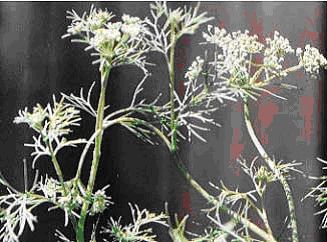Food-Info.net> Food Products > Spices
Ajwain (Trachyspermum ammi)
Plant family
Apiaceae (parsley family)
Botanical synonyms
Carum copticum, Carum ajowan, Ptychotis ajowan, Trachyspermum copticum
Origin
Eastern Mediterranean, maybe Egypt.
The main cultivation areas today are Persia and India, but the spice is of little importance in global trade.
Used plant part
The small, caraway-like fruits.
Sensoric quality
Similar to thyme, but stronger and less subtle.
Main constituents
The essential oil (2.5 to 5% in the dried fruits) is dominated by thymol (35 to 60%); furthermore,
a-pinene, p-cymene, limonene and
a-terpinene have been found.
In the essential oil distilled from aerial parts (flowers, leaves) of ajwain grown in Algeria, however, isothymol (50%) was found to be the dominant constituent before p-cymene, thymol, limonene and
a-terpinene. Note, however, that the name isothymol is not well defined and might refer to both 2-isopropyl-4-methylphenol and 3-isopropyl-6-methylphenol (carvacrol). (Journal of Essential Oil Research, 15, 39, 2003)
From South Indian ajwain fruits, almost pure thymol has been isolated (98%), but the leaf oil was found to be composed of monoterpenoids and sesquiterpenoids: 43% cadinene, 11% longifolene, 5% thymol, 3% camphor and others. (Indian Journal of Pharmaceutical Sciences, 64, 250, 2002).

Ajwain (flowering plant)
Use
Ajwain is not very common in our days; its usage is almost confined to Central Asia and Northern India, particularily the North West (Punjab, Gujarat). Ajwain also enjoys some popularity in the Arabic world and is found in berebere, a spice mixture of Ethiopia which both shows Indian and Arabic heritage.
The strong aroma is enhanced by roasting or frying and goes well with potatoes or fish. Legumes (lentils, beans) are, however, the most important field of application; in India, where these vegetables are popular since they provide a source of protein to the many vegetarians, they are commonly flavoured with a perfumed butter frequently containing ajwain. This seemingly simple preparation is much more sophisticated than sheer heat treatment, since most aroma compounds in spices are lipophilic and dissolve much better in fat than in water. Thus, frying in butter not only enhances the fragrance because of the high temperature, but also extracts the flavour to the fat, whence it can be dispersed throughout the food efficiently.
Source : www-ang.kfunigraz.ac.at/~katzer/engl/spice_welcome.html




